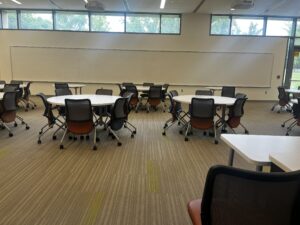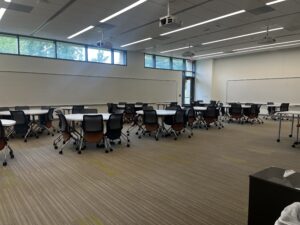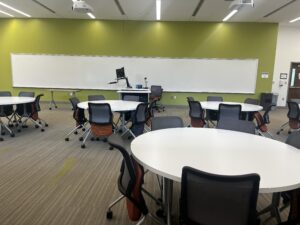Classroom Features, Technology Instructions, and Teaching Tips
This photo gives a specific room view. For precise room capacity and photos showing the furniture and layout of your exact classroom, please log in to 25Live.
Classroom Features
- Touch panel controller
- Instructor credenza with PC and two instructor monitors
- Four projection screens
- Laptop/tablet connection capability (HDMI)
- Document camera
- Instructor microphones (handheld and lavalier)
- Wireless presentation
- Round tables that can be split into half rounds
- Continuous white boards on all walls
- Illustrated Quick Start Guide
- FAQs and Troubleshooting
Technology Instructions and Teaching Tips
Show All | Hide All
Touch panel controller
Instructions
- Touch the panel screen on the console to start the system. In most classrooms, the screen(s) will automatically lower.
- Tap to select the appropriate source button for viewing.
- “PC Main” defaults to the LEFT monitor and LEFT projector. It features AUDIO for all content and supports all annotation.
- “PC Extended” defaults to the RIGHT monitor and RIGHT projector. There is no audio associated with content on this monitor.
- Other source options may include document camera, laptop, and/or wireless depending on the room options.
- See panel screen for volume control and screen-blanking options.
Instructor credenza with PC and two monitors
Instructions
- Note: This small credenza has been positioned against the wall to maximize flow within the classroom and is designed with a moveable display arm that allows instructor to either sit or stand while operating the PC. An additional instructor table is provided.
- If the PC is not already on, check that the monitor is powered on, press the computer power button, or call support: 3-3456.
- Log in with classroom access: Enter the classroom username and password as indicated on the splash screen.
- OPTION: Log in with MESA: Enter your Mason username and password if you need to access your MESA drive. Remember to log out when you are finished.
- To use Ink2Go to annotate electronic documents, to capture snapshots or video of your screen, or to work on live whiteboards and save that work, see additional information here.
Supporting Active and Engaged Learning
- Leave the lectern: Although you can adjust the displays and keyboard to allow you to sit or stand behind them as you present information, this classroom has been designed specifically to encourage additional learning modes. As you plan each class session, you might envision other places in the room where you can stand or sit as you speak with, listen to, or observe your students in their learning.
- Model thinking and problem solving: Use the touch screen on the left like a doc cam and paper to solve problems, annotate texts, or draw a diagram in real time, while sharing your thought process: Turn the screen flat, open a whiteboard in Ink2Go, and use your stylus to write or draw. Or ask a student to come up and model the work for the class. You can also then save the document and post for your students to review later.
- For more teaching tips and examples, visit the Stearns Center’s Active Learning page.
Four projection screens
Instructions
- The projector may take 20-30 seconds to power down, and 20-30 seconds to power up on restart.
- Your screen(s) will automatically roll down when you turn the system on.
- Once the system is on, an automatic screen can be manually controlled by the wall switch if needed.
- See “Touch Panel Controller” for more information on selecting and switching screen content.
Supporting Active and Engaged Learning
- Set up in-class group work efficiently: Use one screen to post the problem set or group activity instructions, and use the other to project an online timer or team roles to keep everyone on track. This will help all students, especially multilingual students, remember their tasks and stay on focused on learning.
- Combine and compare resources for problem solving: Project an informational resource (data set, code, text, essay rubric) on one screen and a problem or activity (directions, discussion questions, problem to solve, student sample essay) on the other. This allows all students to access both the problem and the information they might need to solve the problem at the same time.
- Facilitate a backchannel conversation in real time: Project a live feed (e.g., PollEverywhere, Twitter, Blackboard chat) on one screen to collect students’ questions/responses to a lecture or a class activity while the other screen features presentation materials. This allows you to see the conversation happening in the classroom in real time, allowing presenters to check the pulse of the room and ask/answer questions.
- For more teaching tips and examples, visit the Stearns Center’s Active Learning page.
Laptop or tablet connection capability
Instructions
- Locate the HDMI cable on top of the instructor console. (It may be located in the cable cubby.)
- Place the HDMI cord into the HDMI port on your device or the adapter. (If you do not have an HDMI port, you will need an adapter. If you are using an adapter, plug the adapter into your device.)
- Press the “HDMI” button on the touch panel controller to display your device’s screen. (The touch panel interface will indicate the selected source.)
- Faculty may check out laptops and/or adapters for temporary use from Classroom Support Services in The Mix at Fenwick Library. For longer-term use, please consult your department.
- To troubleshoot issues related to sound and/or image display, see the FAQ page.
Supporting Active and Engaged Learning
- Reporting out from in-class activities: Invite individual students or teams to connect their device to the console to share the results of an in-class activity. After in-class work, not all participants or teams need to report out (this can get tedious), but asking a few to share increases accountability and helps spark discussion about the range of appropriate and innovative responses.
- Sharing student work and peer review: Invite individuals or teams to connect their device to share in-progress drafts of their research, designs, lab reports, or problem sets. Students who present informally and take questions gain confidence and may gain helpful feedback or insight; more importantly, others in the class see real-time problem-solving from their peers and are often reassured that not everyone gets it right the first time. Help students focus their comments on how the document/problem could be improved and what they themselves can learn from it (rather than commenting on the abilities of the student presenting).
- For more teaching tips and examples, visit the Stearns Center’s Active Learning page.
Document camera
Instructions
- Press the “DOC CAM” button on the touch panel controller to select the document camera as the source.
- Place the item on the white square or clear surface–document should be placed face-up.
- For capturing photos and recording videos of your item, insert a USB device into the USB port on the document camera. Press the capture/delete button on the document camera’s control panel to capture a picture of the displayed image.
- Note: Only select document cameras support this functionality. For more tips and instructions, visit the Stearns Center’s Document Camera page.
Supporting Active and Engaged Learning
- Share your students’ finds: Remember that the doc cam can project a view from a student’s phone or tablet (though with varying image quality) and three-dimensional items as well as papers; your students’ backpacks and devices may have examples they can quickly share with the class using the doc cam. Using student examples can help strengthen connections between abstract concepts and their lived experience.
- Modified “gallery walk”: In a classroom with extended whiteboards, a team member can be selected to guide other students through the solution the team posted on the board as they move around the room. Here, using the doc cam, one or two students can bring a written record up to explain to the whole class; if the instructor selects these students at random, then all team members are always accountable for being ready to explain their team’s progress. Explaining and watching others explain the steps that led to a solution is a crucial element in retaining and transferring new knowledge.
- For more teaching tips and examples, visit the Stearns Center’s Active Learning page.
Instructor microphones (handheld and lavalier)
Instructions
- Once the system is powered on via the touch panel controller, the microphones can be used.
- The microphones are located within a drawer in the instructor console or credenza.
- Power on the microphone (handheld) or the microphone receiver (lavalier) before each use.
- Use the touch panel controller for volume adjustments or muting.
- Note: Batteries must be replaced on a regular basis. Spare batteries will also reside in the drawer. For additional spare batteries, contact support: 3-3456.
Supporting Active and Engaged Learning
- Keep all students in the loop: In a large, busy room, using the microphone ensures that all students, including those for whom English is not a native language, can understand all of your instructions and information, and can hear their peers reporting out even when those peers speak softly.
- Keep the learning active: The microphone saves time (you don’t have to repeat yourself), boosts energy (you don’t have to call for a complete stop to provide an update), and lets you operate efficiently (you can speak from anywhere in the room rather than returning to the front or center).
- Build student confidence: Students who “take the mic” can gain presentation and communication skills and build their confidence in having a slightly more formal role in talking to their peers.
- For more teaching tips and examples, visit the Stearns Center’s Active Learning page.
Wireless presentation
Instructions
- Open a browser on your device and enter the IP Address listed on the display
- Click Connect or Get the app
- Type the 4-digit code displayed on your device (the code will be different each time you connect)
- Follow the prompts to share your desktop, an application (Excel, Word, etc.) or a media file
- To troubleshoot related issues, see the Wireless Projection Resource Page.
Supporting Active and Engaged Learning
- Leave the lectern behind: Whether you’re showing slides, demonstrating an online search, updating task directions, or taking notes on students’ ideas for research topics, you can do so using your laptop, tablet, or phone from anywhere in the room, standing or sitting. You are free to interact with groups and individuals as they work. Also, when students focus on the screen or on each other rather than on you, they often generate more attention to the problem or conversation at hand.
- Share student work: Invite individuals or team members to connect wirelessly to share their drafts, problem sets, proposals, or relevant websites with the whole class. Students can share at the end of an activity, or you can invite one or two students to share their work part-way through. Not only do students get to see others’ approaches, but students who share their work in progress can revise or expand it in real time as they receive guided feedback from their peers, helping everyone see the steps involved in learning.
- Let students lead: Wireless presentation not only works for formal student presentations, but also lets you identify a student to “lead from the side” for a few minutes at any point in class. A student can share his/her/their screen, explain their challenges and choices, and draw connections to the overall conversation. Students might model their note-taking strategies, their programming choices, their research steps, their data analysis methods, or their design planning. (If you “cool call” students, letting them know at the start of class that you’ll be asking them to talk for a minute or two about a project or question, they may be more ready to step into this role.)
- For more teaching tips and examples, visit the Stearns Center’s Active Learning page.
Round tables that can be split into half rounds
Supporting Active and Engaged Learning
- Match the attention focus to the activity: Rows focus students’ attention on a single presenter; a U-shape focuses students’ attention on the whole group for discussion; smaller pods focus students’ attention on a team or partner for active learning or projects. If you brief students on your favorite room arrangements early in the term, you can ask them to quickly help you set the stage for the learning you plan to have happen.
- Get students up and moving: Clear the furniture away to the sides of the room to create an open space in the middle of the room for an icebreaker activity, a scavenger hunt, or a role play–or move furniture to the middle of the room to allow students or teams more room at the whiteboards.
- Move between collaborative and individual work stations: Pushing tables or desks together facilitates partner and/or group work for activities like peer review, collaborative problem solving, small group peer teaching, jigsaw reading and reporting out activities, group testing, or working with manipulatives (like Legos). Remember, group sizes and table configurations can be rearranged even within a class session if a subsequent activity calls for individual work space for assessment activities or individual reflection or work.
- For more teaching tips and examples, visit the Stearns Center’s Active Learning page.
Continuous white boards on all walls
Supporting Active and Engaged Learning
- Match the attention focus to the activity: Rows focus students’ attention on a single presenter; a U-shape focuses students’ attention on the whole group for discussion; smaller pods focus students’ attention on a team or partner for active learning or projects. If you brief students on your favorite room arrangements early in the term, you can ask them to quickly help you set the stage for the learning you plan to have happen.
- Get students up and moving: Clear the furniture away to the sides of the room to create an open space in the middle of the room for an icebreaker activity, a scavenger hunt, or a role play–or move furniture to the middle of the room to allow students or teams more room at the whiteboards.
- Move between collaborative and individual work stations: Pushing tables or desks together facilitates partner and/or group work for activities like peer review, collaborative problem solving, small group peer teaching, jigsaw reading and reporting out activities, group testing, or working with manipulatives (like Legos). Remember, group sizes and table configurations can be rearranged even within a class session if a subsequent activity calls for individual work space for assessment activities or individual reflection or work.
- For more teaching tips and examples, visit the Stearns Center’s Active Learning page.



